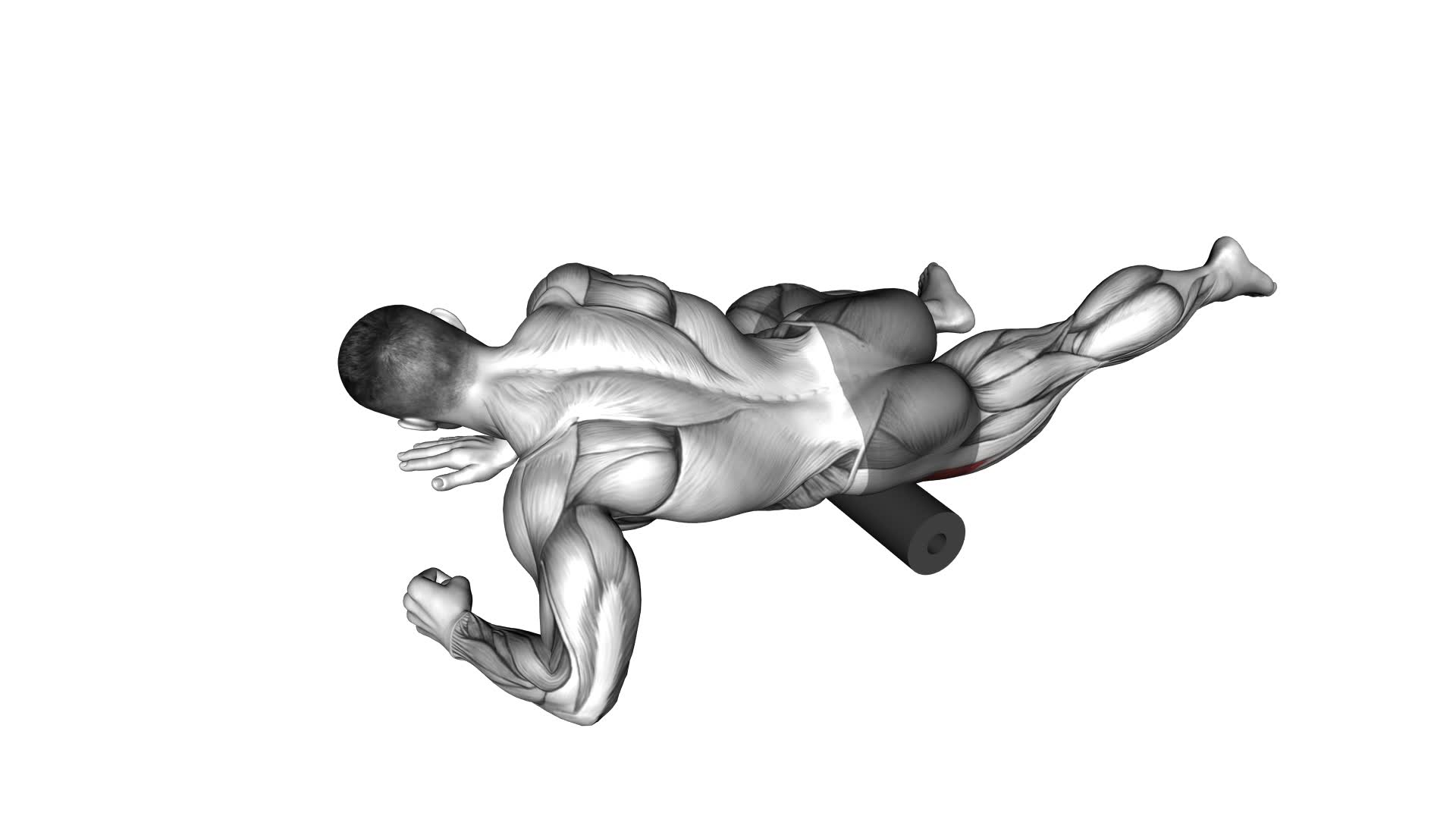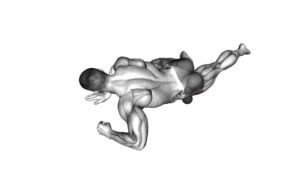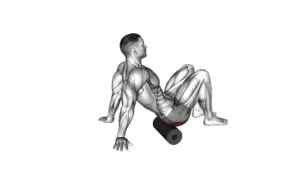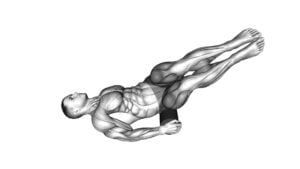Roll Tensor Fasciae Latae – Video Exercise Guide & Tips

Looking to improve your fitness routine? Check out this video exercise guide and tips for rolling your tensor fasciae latae.
Watch This Exercise Video
This short and informative article will show you the benefits of this exercise, the equipment you'll need, and the proper technique to follow.
Avoid common mistakes and discover variations to take your workout to the next level.
Incorporate this exercise into your routine for better flexibility and strength.
Let's get rolling!
Key Takeaways
- Rolling the Tensor Fasciae Latae can improve flexibility, reduce muscle tension, enhance athletic performance, and increase range of motion in the hip joint.
- The exercise requires specific equipment such as a foam roller, exercise mat, resistance band, and a rolled-up towel or tennis ball as an alternative for the foam roller.
- Proper technique involves maintaining neutral spine and body alignment, engaging core muscles for stability, activating glutes and inner thighs, correcting posture and muscle imbalances, and focusing on core engagement throughout the exercise.
- Common mistakes to avoid include incorrect hip alignment, overworking the muscle, inadequate warm-up, straining hip joints due to pelvic tilt, and maintaining proper alignment of knees and ankles.
Benefits of the Tensor Fasciae Latae Roll
What are the benefits of rolling the Tensor Fasciae Latae?
Rolling the Tensor Fasciae Latae, or TFL, can provide numerous benefits for your body and overall health. This small muscle located on the outside of your hip plays a crucial role in hip stabilization and movement. By regularly incorporating TFL rolling exercises into your fitness routine, you can experience improved flexibility, reduced muscle tension, and enhanced athletic performance.
One of the primary benefits of rolling the TFL is increased flexibility. This muscle can become tight and restricted, especially if you engage in activities that require repetitive hip movements, such as running or cycling. Rolling the TFL helps to release tension and lengthen the muscle fibers, allowing for a greater range of motion in the hip joint.
Additionally, TFL rolling can help reduce muscle tension and alleviate discomfort. When the TFL muscle is tight, it can lead to hip pain, lower back pain, and even knee pain. By applying pressure to the TFL through rolling, you can help relax the muscle and relieve any associated discomfort.
Lastly, rolling the TFL can improve athletic performance. A flexible and relaxed TFL allows for smoother and more efficient hip movement, which can enhance your performance in activities such as running, jumping, and agility exercises.
Incorporating TFL rolling exercises into your fitness routine can provide numerous benefits, including increased flexibility, reduced muscle tension, and improved athletic performance. Make sure to consult with a healthcare professional or fitness expert before starting any new exercise regimen.
Equipment Needed for the Exercise
To properly perform the Tensor Fasciae Latae roll, you'll need a few pieces of equipment. Here are the items you'll need:
- Foam Roller: A foam roller is an essential tool for this exercise. It helps to target and release tension in the Tensor Fasciae Latae muscle.
- Exercise Mat: An exercise mat provides a comfortable surface for you to lie down on while performing the roll. It also helps to stabilize your body during the exercise.
- Resistance Band: Adding a resistance band to the Tensor Fasciae Latae roll can increase muscle activation and provide a more challenging workout. It allows you to add resistance and work the muscle in different directions.
Using the right equipment is crucial for maximizing the benefits of the Tensor Fasciae Latae roll.
However, it's important to note that there are exercise modifications available if you don't have access to these specific items. For example, if you don't have a foam roller, you can use a rolled-up towel or a tennis ball to target the muscle. Similarly, if you don't have a resistance band, you can perform the exercise without it and still achieve effective results.
Remember to listen to your body and make any necessary adjustments to ensure proper form and safety during the exercise.
Proper Technique for the Roll
To perform the roll for the Tensor Fasciae Latae exercise with proper technique, it's important to focus on correct body alignment and engage the targeted muscles effectively.
Maintain a neutral spine, align your shoulders with your hips, and engage your core muscles to stabilize your body during the movement.
Additionally, use muscle engagement cues such as squeezing your glutes and activating your inner thighs to enhance the effectiveness of the exercise.
Correct Body Alignment
Maintain proper body alignment by positioning yourself correctly for the roll. This is crucial to prevent injuries and optimize the effectiveness of the exercise.
Here are three important factors to consider:
- Correct posture: Start by lying on your side with your bottom leg straight and your upper leg bent at a 90-degree angle. Keep your spine neutral and your head in line with your body.
- Muscle imbalances: Pay attention to any imbalances in your hips and pelvis. If you notice one side is weaker or tighter than the other, focus on engaging and stretching those muscles accordingly.
- Core engagement: Activate your core muscles by gently pulling your belly button towards your spine. This helps stabilize your torso and support proper alignment throughout the roll.
Muscle Engagement Cues
To ensure proper technique for the roll, focus on engaging the muscles of your tensor fasciae latae and maintaining core stability. Engaging these muscles is crucial for effective muscle activation and maximizing the benefits of the exercise.
Start by lying on your side with your bottom leg straight and your top leg bent at the knee. Place a foam roller under your bottom leg, just above the knee. As you roll forward and backward, concentrate on activating the tensor fasciae latae by pressing down into the foam roller with your leg. This engagement will help to strengthen and stabilize your hip and thigh muscles.
Remember to maintain core stability throughout the exercise by keeping your abdominal muscles engaged and your spine in a neutral position.
Common Mistakes to Avoid
When performing the roll tensor fasciae latae exercise, it's important to be aware of common mistakes to avoid.
One common mistake is incorrect hip alignment, which can put unnecessary strain on the muscle.
Another mistake is overworking the muscle, which can lead to fatigue and potential injury.
Lastly, failing to properly warm up before performing the exercise can increase the risk of muscle strain or injury.
Incorrect Hip Alignment
Correcting hip alignment is crucial for proper form and injury prevention during the roll tensor fasciae latae exercise. Incorrect hip alignment can lead to hip misalignment and hip pain, hindering your progress and potentially causing injury.
To ensure correct hip alignment, keep the following in mind:
- Maintain a neutral pelvis: Avoid tilting your pelvis forward or backward, as this can create strain on the hip joints.
- Engage your core: A strong core helps stabilize the pelvis and maintain proper alignment throughout the exercise.
- Align your knees and ankles: Make sure your knees are in line with your ankles, preventing any inward or outward rotation that can put stress on the hips.
Overworking the Muscle
Avoid overworking the muscle by maintaining proper form and not pushing yourself beyond your limits during the roll tensor fasciae latae exercise. Overuse injuries and muscle strain can occur when you put too much stress on the muscle or perform the exercise incorrectly.
It's important to listen to your body and stop if you feel any pain or discomfort. Remember to start with a gentle pressure and gradually increase it as your muscles become more accustomed to the exercise. Be mindful of any imbalances or weaknesses in your body and adjust your technique accordingly.
Additionally, make sure to incorporate rest days into your workout routine to allow your muscles to recover and prevent overuse injuries.
Lack of Proper Warm-Up
To prevent potential injuries, ensure you properly warm up before performing the roll tensor fasciae latae exercise. A lack of proper warm-up can increase the risk of strains, sprains, and muscle tears.
Here are three important reasons why warming up is essential for preventing injuries and improving flexibility:
- Increased blood flow: A warm-up increases blood circulation to the muscles, delivering oxygen and nutrients while removing waste products. This helps prepare the muscles for exercise and reduces the risk of injury.
- Improved muscle elasticity: Warming up helps improve the flexibility and elasticity of the muscles, making them more responsive and less prone to strains or tears.
- Enhanced joint mobility: A proper warm-up routine includes dynamic stretches that target the joints, improving their range of motion and reducing the risk of joint-related injuries.
Variations and Progressions of the Exercise
To enhance the effectiveness of the roll tensor fasciae latae exercise, you can incorporate various variations and progressions. These variations and progressions not only add diversity to your workout routine, but also challenge your muscles in new ways, leading to improved strength and flexibility.
One variation of the roll tensor fasciae latae exercise is to use a foam roller with ridges or bumps. This adds an extra level of intensity by increasing the pressure on the targeted muscles. By rolling over these textured surfaces, you can effectively release tension and knots in the tensor fasciae latae.
Another variation is to perform the exercise with one leg lifted off the ground. This increases the load on the working leg, making the exercise more challenging and demanding. It requires greater stability and core engagement to maintain balance while rolling.
As you progress in your strength and flexibility, you can also increase the duration of the exercise. Start with shorter rolling sessions and gradually increase the time spent on each leg. This will further enhance the benefits of the exercise by allowing for deeper muscle release and activation.
Incorporating these variations and progressions into your roll tensor fasciae latae exercise routine will help you continually challenge your muscles and achieve better results. Remember to listen to your body and start with variations that are suitable for your current fitness level.
Tips for Incorporating the Exercise Into Your Fitness Routine
To successfully incorporate the roll tensor fasciae latae exercise into your fitness routine, consider these helpful tips:
- Start Slow: If you're new to this exercise, it's important to start slow and gradually increase the intensity. Begin with a foam roller placed under your tensor fasciae latae (TFL) muscle, and roll back and forth for about 30 seconds on each side. As you become more comfortable, you can increase the duration and pressure.
- Incorporate Modifications: To make the exercise more challenging or target different areas, you can incorporate modifications. For example, you can try using a massage ball instead of a foam roller or add a resistance band for added tension. These modifications can help you progress and continue challenging your muscles.
- Benefits of Regular Practice: Consistently practicing the roll tensor fasciae latae exercise can provide numerous benefits. It helps release tension in the TFL muscle, which can alleviate hip and knee pain. Additionally, regular practice can improve mobility, increase flexibility, and enhance overall athletic performance.
Incorporating modifications and regularly practicing the roll tensor fasciae latae exercise can significantly improve your fitness routine. Remember to start slow, listen to your body, and gradually progress as you become more comfortable. With time and consistency, you'll experience the many benefits this exercise has to offer.
Frequently Asked Questions
How Often Should I Perform the Tensor Fasciae Latae Roll Exercise?
To maximize the benefits of stretching the tensor fasciae latae and avoid common mistakes, it's important to perform the roll exercise regularly. Aim to do it at least two to three times a week.
Consistency is key to improving flexibility and reducing tightness in this muscle. By incorporating this exercise into your routine, you can help prevent injuries, improve hip mobility, and enhance overall performance.
Remember to listen to your body and adjust the frequency based on your individual needs.
Can the Tensor Fasciae Latae Roll Help With Hip Pain?
The tensor fasciae latae roll can be beneficial in relieving hip pain. By targeting the tensor fasciae latae muscle, this exercise helps to release tension and tightness in the hip area.
The technique involves using a foam roller to apply pressure and roll along the outer thigh. Regularly performing this exercise can help improve hip mobility and reduce discomfort.
Make sure to consult with a healthcare professional before starting any new exercise regimen.
Is the Tensor Fasciae Latae Roll Suitable for Beginners?
The tensor fasciae latae roll is a technique that can be suitable for beginners. It's a great exercise to target the tensor fasciae latae muscle, which is located on the side of your hip.
By rolling on a foam roller or massage ball, you can release tension and tightness in this muscle, improving hip mobility and reducing hip pain.
Incorporating the tensor fasciae latae roll into your routine can bring many benefits to your overall hip health.
Are There Any Modifications for Individuals With Limited Mobility?
If you have limited mobility, there are modifications you can make to the tensor fasciae latae roll exercise. These modifications allow you to still engage the targeted muscle group while accommodating your mobility needs.
By adjusting the range of motion or using props for support, you can customize the exercise to suit your abilities.
It's important to consult with a qualified fitness professional to determine the most appropriate modifications and exercises for your specific limitations.
Can the Tensor Fasciae Latae Roll Improve Athletic Performance?
The roll tensor fasciae latae exercise can indeed improve athletic performance. By rolling this muscle, you aren't only improving flexibility in your hips, but also activating the hip muscles.
This increased flexibility and activation can lead to better performance in athletic movements that require hip mobility and stability. Incorporating the roll tensor fasciae latae exercise into your training routine can help enhance your athletic abilities and prevent injuries.
Conclusion
Incorporating the Tensor Fasciae Latae Roll into your fitness routine can provide numerous benefits, such as improving hip mobility and reducing muscle tension.
By using the proper technique and avoiding common mistakes, you can effectively target this muscle group.
Additionally, variations and progressions of the exercise can help you challenge yourself and continue to see improvements.
Make sure to include this exercise in your routine to enhance your overall fitness and performance.

Author
Years ago, the spark of my life’s passion ignited in my mind the moment I stepped into the local gym for the first time. The inaugural bead of perspiration, the initial endeavor, the very first surge of endorphins, and a sense of pride that washed over me post-workout marked the beginning of my deep-seated interest in strength sports, fitness, and sports nutrition. This very curiosity blossomed rapidly into a profound fascination, propelling me to earn a Master’s degree in Physical Education from the Academy of Physical Education in Krakow, followed by a Sports Manager diploma from the Jagiellonian University. My journey of growth led me to gain more specialized qualifications, such as being a certified personal trainer with a focus on sports dietetics, a lifeguard, and an instructor for wellness and corrective gymnastics. Theoretical knowledge paired seamlessly with practical experience, reinforcing my belief that the transformation of individuals under my guidance was also a reflection of my personal growth. This belief holds true even today. Each day, I strive to push the boundaries and explore new realms. These realms gently elevate me to greater heights. The unique combination of passion for my field and the continuous quest for growth fuels my drive to break new ground.







